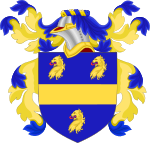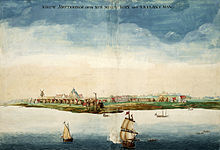Richard Nicolls
Richard Nicolls | |
|---|---|
| 1st Director-General of New Netherland) | |
| Succeeded by | Francis Lovelace |
| Personal details | |
| Born | 1624 Ampthill, Bedfordshire, England |
| Died | 28 May 1672 (aged 47–48) North Sea, off Suffolk |
| Relations |
|
| Parents |
|
| Signature | |
Richard Nicolls (sometimes written as Nichols, 1624 – 28 May 1672) was the first
Early life
Nicolls was born in 1624 in

Career
He commanded a royalist troop of horse (i.e., cavalry) during the
Province of New York
Through the influence of the Duke of York, in 1664 Nicolls was appointed to a commission with Sir Robert Carr (d. 1667), George Cartwright, and

He made 74th Street, beginning at the East River, the southern border patent line (which was called the "Harlem Line") of the village of Nieuw Haarlem (later, the village of Harlem); the English also renamed the village "Lancaster".[5][6][7][8]
Legal System
His policy was vigorous but tactful, and the transition to the new regime was made smoothly and with due regard to the interests of the conquered people. The formerly Dutch colonists were guaranteed in the possession of their property rights, their laws of inheritance, and the enjoyment of religious freedom. The English system of law and administration was at once introduced into Long Island, Staten Island and Westchester, where the English element already predominated, but the change was made much more slowly in the Dutch sections.
A code of laws, known as the "
Return to England
Nicolls returned to England in the summer of 1668 and continued in the service of the Duke of York. He was replaced by Francis Lovelace as New York governor. He was killed in the naval battle of Southwold Bay on 28 May 1672. His monument at Ampthill incorporates the cannonball that killed him.[1]
References
- Notes
- ^ a b c "Richard Nicolls | English governor". britannica.com. Encyclopædia Britannica. Retrieved 29 September 2017.
- ^ "Papers on Mining in Scotland, 18th and 19th centuries". Archives Hub. Archived from the original on 1 August 2012. Retrieved 17 October 2008.
- ^ Weeks, Lyman Horace (1907). Book of Bruce; ancestors and descendants of King Robert of Scotland. Being an historical and genealogical survey of the kingly and noble Scottish house of Bruce and a full account of its principal collateral families. With special reference to the Bruces of Clackmannan, Cultmalindie, Caithness, and the Shetland Islands, and their American descendants. New York: The Americana Society.
- ^ "Articles about the Transfer of New Netherland on the 27th of August, Old Style, Anno 1664". World Digital Library. Retrieved 8 February 2013.
- ISBN 9780199772919. Retrieved 13 April 2013.
- ISBN 9780738509860. Retrieved 13 April 2013.
- ISBN 9780738554785. Retrieved 10 April 2013.
- ^ "Mount Morris Bank Building" (PDF). Landmarks Preservation Committee. 5 January 1993. Archived from the original (PDF) on 25 March 2016. Retrieved 10 April 2013.
- Sources
- This article incorporates text from a publication now in the public domain: Chisholm, Hugh, ed. (1911). "Nicolls, Richard". Encyclopædia Britannica. Vol. 19 (11th ed.). Cambridge University Press. pp. 663–664.
